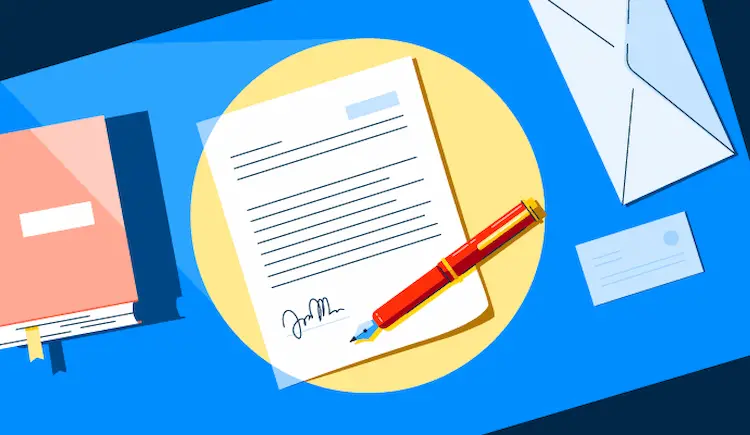Letters are a common tool of communication in professional situations. You will likely need to write a business letter at some point in your life.
Despite technological advancement, many formal correspondences use printed business letters, including employment offers, reference letters, and job verification.
Business letters communicate high-value information. Polishing your letter according to the universal guidelines will promote effective message communication.
The Modern Language Association (MLA) is the most common format for writing business letters. The rules outline the language and layout followed when writing all sections of a formal letter.

Thus, it is critical to understand some essential tips on how to write a letter in business format to ensure you write effectively on your own. Read on to discover how you can craft a letter in business format.
Also Read on Communication: Benefits of Online Communication for Businesses
Sections of a Letter Written in Business Format
Writer’s Details
The Letter starts with details of the writer at the top. The section contains the contact and address details of the sender. If you have a letterhead with your details, you don’t need to re-write them again.
Date
The date is mandatory when you write a business letter. You place the date below the writer’s details. Ensure you use the correct format depending on the recipient’s location.
Receiver’s Details
You must address the letter to the specific recipient to prevent it from getting lost or ending up in the wrong hands. The necessary details are their name, title, organization’s name, zip code, and telephone number. The information should fit the window of the envelope.
Greeting
The central part of the business letter starts with a salutation. The greeting can begin with ‘dear,’ followed by the receiver’s name. Make sure you punctuate the greeting correctly using a colon.
The Body
After the greetings, you can start writing the letter’s purpose. Don’t use jargon, long sentences, or unnecessary details. Start by mentioning the letter’s purpose and proceed to the details in the following paragraphs.
Writing a letter in business format requires you to be concise. Ensure you include specific details without sounding obnoxious—end by thanking the recipient for their attention. You can also add a call to action depending on the message in the letter.
Skip a line to separate different paragraphs in the body section of the letter.
Your Signature
The kind of signature you add to a business letter depends on your connection with the receiver. It should be as simple as your initials, your credentials, or your name.
The signature is handwritten and not typed. If you need to add a stamp, you can leave space for it in this section of the letter.
Attachments
In case of any attachments enclosed in the envelope, list their names at the bottom of the letter.
Font and Format for Writing a Business Letter

Block Format
This is the most common format for writing formal letters. The style involves justifying all the text in the letter to the left. In the block format, you separate the paragraphs using double spacing while the lines are single-spaced.
Modified Block
The date and signature are centered when you write a letter using the modified block. However, the other sections, such as the body and addresses, are justified to the left. There is a single spacing between the lines.
Semi-Block
Formal business letters rarely adopt the semi-block style. The structure resembles the modified block, but the text is not justified to the left. Instead, you indent the paragraphs with five spaces.
Font
The choice of lettering plays a critical role in the readability of any paper. A formal letter should use a font that makes a positive impression on the reader.
The recommended fonts are Times New Roman and Ariel. You can also use other fonts as long as they are not intricate. The ideal size for all types of fonts is 12.
Punctuation
A letter that is well-executed should have the correct punctuations. For example, the closing should have commas, while the salutation should end with a colon. Many people make the mistake of interchanging the two punctuations.
How to Write a Business Letter: 8 Essential Tips
Seek the Help of a Professional Writer
The quality of your business communication affects your career, irrespective of your professional level or industry. If you find it hard to design a flawless business letter, don’t get desperate because online paper writing services can assist you with any writing emergency.
You can get help from an experienced business writer who reviews your drafts or writes your business letter from scratch. Outsourcing a paper is a great way to accomplish your tasks faster and with guaranteed quality content.
Custom Writings is a reputable writing service with professional writers available 24/7 to help you cheaply design a personalized business letter.
Plan
Make a rough draft of the purpose of the letter by listing the key points you want to communicate to the sender. Sometimes, you may need to confirm some details with other people. Planning helps to minimize ambiguities and misinterpretations.
One page is Enough
Keep the letter as short as possible. There is no need to highlight details already contained in the attachments. A special note is more likely to get an answer than a long one.
Tone
Professional business messages take a formal tone. Do not use passive voice, exclamation marks, or idioms when writing a letter in business format.
Instead, communicate straightforwardly to ensure the reader takes you seriously and understands precisely what you mean.
Co-workers and Friends
Maintain the formal structure of a business letter even when you are communicating with friends and co-workers. For instance, avoid swearing in official communication even if your discussions contain such words.
Profanities can have severe consequences when discovered in official correspondence.
Demonstrate your Expertise
Communicating in a way that makes you sound smart is always good. You can achieve that by including a few technical terms you know the receiver will understand.
Call-to-Action
Tell the receiver if there is any action that you expect them to take after reading your letter. For example, you can ask them to confirm receipt or the next step in your communication.

Be Frank but Also Polite
Honesty is essential when you write a business letter. Call things by their names to increase the clarity of your message.
Ensure you relay information politely and diplomatically, especially when communicating bad news. Still, always say things as they are.
Conclusion
How you write a business letter can be the difference between success and failure. You don’t want to appear careless or sloppy. Follow the tips provided in this guide to improve your business letter writing skills.